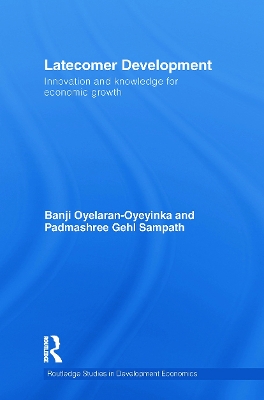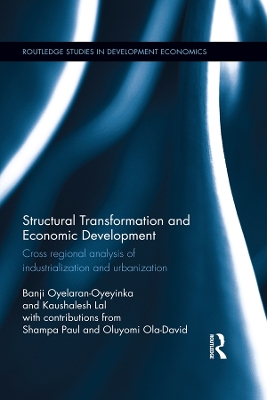Routledge Studies in Development Economics
1 primary work • 4 total works
Book 75
Latecomer Development
by Banji Oyelaran-Oyeyinka and Padmashree Gehl Sampath
The most important issue for development centres on the debate about the centrality of knowledge, technology and innovation to the process of economic development. While this much is broadly agreed, what is at issue is the precise mechanics of overcoming economic development challenges in different contexts. At the heart of it all is about how economies at different levels deploy the unending streams of information and knowledge to developmental ends. In time, the notion of income convergence between the poorer South and the wealthy North has proved a mirage, while a new economic divide has in fact occurred within the South itself, and as well, between regions and within regions. The debate relating to latecomers is thus framed in discussions about regions and countries that arrive late to mastering industrialization in achieving economic prosperity through the use of knowledge. In other words, a new divide has emerged among the latecomers themselves, and with it, greater conceptual complexity in the ways of our understanding of the divergent ways of economic development. We have thus separated "fast followers" and new "late comers".
This book enters this debate acutely aware of the complexity of this process. The authors argue that economic development is largely driven by innovation, concentrating on the dynamics of process, product and organizational changes and how they are embedded within specific and varied contextual institutions.
Latecomer Development: Innovation and Knowledge for Economic Growth
by Banji Oyelaran-Oyeyinka, Gehl Sampath Padmashree, and Padmashree Gehl Sampath
Structural Transformation and Economic Development
by Banji Oyelaran-Oyeyinka and Kaushalesh Lal
This book examines long-term structural changes and the broad impact on economic development in regional comparative perspectives. The book analyzes data across Africa, Asia and Latin America. It looks at key variables of productivity growth, industrialization, poverty, urbanization, and employment. This book is concerned with understanding structural change dynamics and how it affects job creation, living standards, and the efficiency of productive cities through manufacturing productivity growth that benefits majority of citizens.
With empirical evidence from a selected number of developing countries including China, India, Brazil, Nigeria and South Africa, the book attempts to present the considerable structural changes of these countries over the last few decades. It highlights that growth without the expected job creation is one of the distinct features of growth in emerging and developing countries. It suggests that countries may well record economic growth, whether through within sector productivity increase or through structural change, but this may not necessarily lead to employment, an important concern for long-term development.
Industrialization and Economic Diversification
by Banji Oyelaran-Oyeyinka and Kaushalesh Lal
Economic diversification entails a shift away from a single income source toward multiple income sources from an increasing spectrum of sectors and markets. A persistent concern for some Asian and African economies is their reliance on commodity exports and how they are exposed to the risk of export volatility and income instability. The Covid-19 pandemic and previous oil crashes have demonstrated the adverse impact on such economies. This book provides a systemic analysis of sustainable economic development through economic diversification.
The book analyzes diversification and development experiences from comparative perspectives of Asia and Africa. It also investigates determinants of export diversification differentiated by commodities-dependence versus manufactured products and looks at the roles of various institutions and governance of institutions in export diversification.
This book will provide policy insights into how different degrees of specialisation in exports across countries have affected outcomes in terms of living standards, economic growth and employment.



